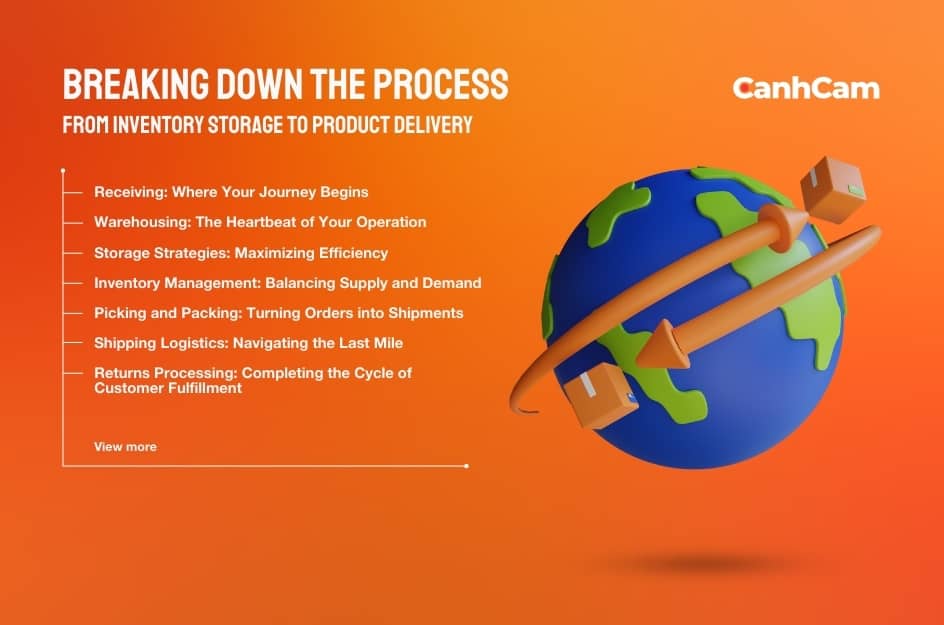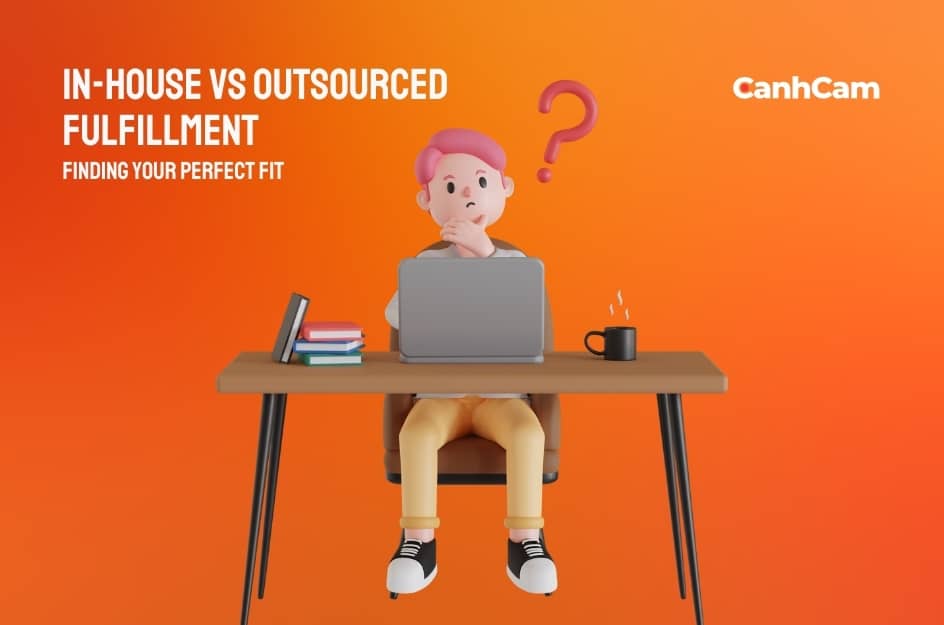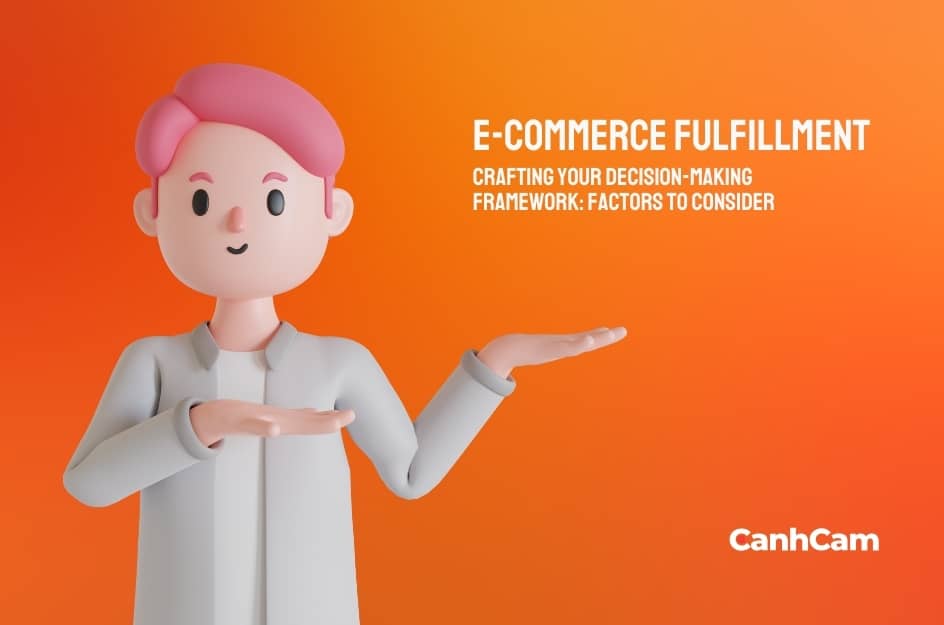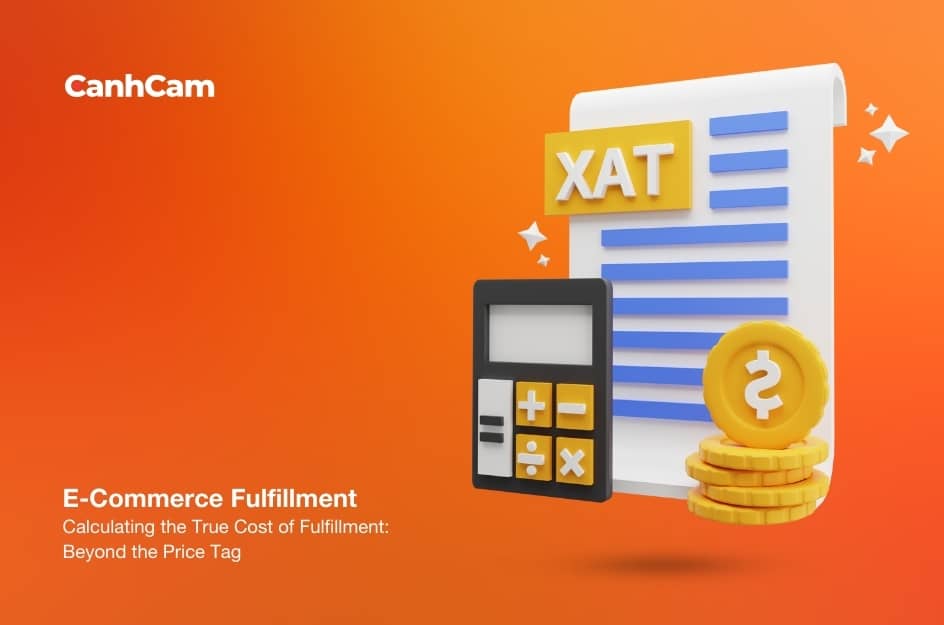Ecommerce order fulfillment is like the heart of keeping customers happy. It covers everything from when you order something to when it shows up at your door, dealing with all the details that affect how you feel about the whole shopping experience.
Ecommerce order fulfillment is basically about getting the right stuff, packing it up nicely, and sending it off to customers. This involves keeping track of what's in stock, finding where things are stored, whether it's in a warehouse or a regular store, wrapping things up, and making sure everything gets delivered on time.
Process of Ecommerce Order Fulfillment
To understand ecommerce order fulfillment, it's essential to dissect its multifaceted process, which begins with receiving and ends with product delivery. Each stage, from warehousing to shipping logistics, plays a pivotal role in ensuring a seamless experience for your customers.
Receiving
At the inception of the order fulfilment process lies the receiving stage. This is where incoming inventory is carefully logged, inspected, and organized within your warehouse facility. Efficient receiving sets the stage for streamlined operations downstream.
Warehousing
Warehousing serves as the epicenter of ecommerce order fulfillment, acting as the nerve center where products are stored, managed, and prepared for shipment. A well-organized warehouse optimizes space utilization and facilitates swift access to inventory when orders are received.

Ecommerce order fulfilment includes processing, packing, shipping, and tracking orders for accurate and timely delivery.
Visit our service: Website Design in Melbourne, Australia
Storage Strategies
Employing effective storage strategies is paramount in optimizing warehouse efficiency. Implementing techniques such as bin location systems, vertical storage solutions, and ABC analysis can help maximize space utilization and streamline order fulfilment processes.
Inventory Management
Central to successful ecommerce order fulfillment is proficient inventory management. By maintaining optimal stock levels, mitigating stockouts, and anticipating demand fluctuations, businesses can ensure timely order fulfilment and prevent customer dissatisfaction.
Picking and Packing
The picking and packing stage represents the pivotal moment where orders are translated into tangible shipments. Adopting efficient picking methods, such as batch picking or zone picking, can expedite the fulfilment process and enhance overall productivity.
Shipping Logistics
Navigating the intricate web of shipping logistics is essential for ensuring timely and cost-effective delivery to your customers. From carrier selection to route optimization, each decision impacts the final leg of the delivery journey—the last mile.
Returns Processing:
Completing the cycle of customer fulfilment involves adeptly managing returns and exchanges. A streamlined returns process not only fosters customer satisfaction but also provides valuable insights for enhancing product quality and customer experience.
In-House vs. Outsourced Order Fulfillment
When deliberating order fulfilment options, businesses must weigh the merits of in-house operations against the benefits of outsourcing to third-party logistics (3PL) providers. Each approach offers distinct advantages and challenges that warrant careful consideration.
Read more: How to Increasing Sales through Ecommerce Analytics?
In-House Fulfillment
Opting for in-house fulfilment affords businesses unparalleled control over every aspect of the fulfilment process, from inventory management to shipping procedures. This level of customization enables businesses to tailor their operations to meet specific customer demands and quality standards.
Third-Party Logistics (3PL) Providers
Outsourcing fulfilment to third-party logistics (3PL) providers offers businesses scalability and expertise without the burden of managing warehouse operations internally. Leveraging the infrastructure and resources of a 3PL provider can expedite order processing and expand market reach.

In-house offers control, but outsourcing provides scalability and expertise sans upfront costs.
Fulfillment Centers
Fulfilment centres serve as external warehousing solutions that cater to businesses seeking to streamline their fulfilment operations without investing in physical infrastructure. By leveraging fulfilment centre services, businesses can focus on core competencies while entrusting fulfilment tasks to experienced professionals.
Last-Mile Delivery
The final leg of the fulfilment journey, last-mile delivery, is crucial for leaving a lasting impression on customers. Harnessing innovative delivery technologies and strategic partnerships with local carriers can optimize last-mile logistics and exceed customer expectations.
Dropshipping
Dropshipping presents a unique fulfilment model that minimizes upfront investment and operational overhead while offering maximum flexibility. By leveraging dropshipping partnerships, businesses can expand product offerings and test new markets with minimal risk.
Pros and Cons: What You Need to Know Before Deciding?
Before committing to an order fulfilment solution, it's imperative to weigh the benefits and drawbacks of each approach. By conducting a comprehensive analysis, businesses can make informed decisions that align with their operational needs and growth objectives.
In-House Fulfillment
While in-house fulfilment offers unparalleled control and customization, it entails significant upfront investments in infrastructure, labour, and technology. Businesses must carefully assess the long-term costs and scalability limitations associated with maintaining in-house operations.

3PL Providers
Outsourcing fulfilment to 3PL providers enables businesses to scale up operations rapidly while tapping into external expertise and infrastructure. However, relinquishing control over certain aspects of the fulfilment process may necessitate clear communication and performance monitoring to ensure alignment with business objectives.
Dropshipping
Dropshipping lowers entry barriers for aspiring entrepreneurs by eliminating the need for inventory management and upfront capital investment. Nonetheless, reliance on third-party suppliers introduces inherent risks, such as product quality issues and supply chain disruptions, which can impact customer fulfilment.
Crafting Your Decision-Making Framework
Crafting a decision-making framework for fulfilment solution selection involves evaluating various factors, including order volume, product type, budget constraints, and growth plans. By prioritizing these considerations, businesses can align their fulfilment strategy with overarching goals and objectives.
Order Volume
The volume of orders processed daily serves as a critical determinant in selecting an appropriate fulfilment solution. Businesses experiencing fluctuating order volumes may benefit from flexible fulfilment options that can scale up or down to accommodate demand fluctuations.
Product Type
The nature of your product portfolio influences the fulfilment solution that best suits your business needs. From perishable goods requiring specialized storage facilities to oversized items necessitating customized shipping solutions, tailoring fulfilment to your inventory ensures optimal product handling and customer satisfaction.

Crafting an ecommerce order fulfillment framework involves structuring efficient decision-making processes.
Budget Constraints
Budget considerations play a pivotal role in fulfilment solution selection, as businesses seek to strike a balance between cost-effectiveness and service quality. Evaluating upfront investment requirements, ongoing operational expenses, and potential cost-saving opportunities is essential for optimizing budget allocation and maximizing ROI.
Growth Plans
Anticipating future growth trajectories is paramount when selecting a fulfillment solution that can scale alongside your business. Whether expanding into new markets or diversifying product offerings, aligning fulfilment capabilities with long-term growth plans fosters agility and sustainable expansion.
Calculating the True Cost of Ecommerce Order Fulfillment
When assessing fulfilment solutions, it's essential to look beyond the surface-level price tag and consider the comprehensive cost implications. Factoring in upfront investments, operational expenses, and long-term savings enables businesses to make informed decisions that optimize cost efficiency and drive sustainable growth.
Upfront Investments
Opting for in-house fulfilment entails substantial upfront investments in infrastructure, technology, and personnel. While these initial costs may seem daunting, they afford businesses greater control over operations and the potential for long-term cost savings through optimized efficiencies.
Operational Expenses
In addition to upfront investments, businesses must account for ongoing operational expenses associated with fulfilment operations. These include labour costs, facility maintenance, utility bills, and transportation fees, which can accumulate over time and impact overall profitability if left unmanaged.
Long-Term Savings
Despite the initial investment required, in-house fulfilment offers the potential for long-term savings through optimized efficiency and cost control. By leveraging technology integration, process automation, and strategic inventory management, businesses can minimize wastage and maximize resource utilization for sustainable growth.

Calculating the true cost of ecommerce order fulfilment is crucial for business profitability.
Optimizing Your Fulfillment Strategy
Technology integration lies at the heart of optimizing fulfilment operations, enabling seamless connectivity between various platforms and systems. Embracing order management software, inventory tracking systems, and automated workflows enhances efficiency, accuracy, and responsiveness throughout the fulfilment process.
Mastering Inventory Management
Effective inventory management is essential for maintaining optimal stock levels and minimizing stockouts or overstock situations. Implementing inventory optimization techniques such as just-in-time inventory, demand forecasting, and SKU rationalization empowers businesses to strike the perfect balance between supply and demand.
Shipping Strategies for Success
Navigating shipping logistics requires a delicate balance between speed, cost-effectiveness, and meeting customer expectations. Adopting shipping strategies such as zone skipping, split shipments, and carrier diversification enables businesses to optimize delivery times, reduce shipping costs, and enhance customer fulfilment.
Returns Management
Returns management presents a unique opportunity for businesses to turn challenges into opportunities for customer satisfaction. By streamlining the returns process, offering hassle-free return policies, and leveraging data analytics to identify underlying trends, businesses can enhance customer experience and foster long-term loyalty.
Frequently Asked Questions (FAQs)
1. What is ecommerce order processing?
The order processing is the set of operations that follows after a customer makes an order. The first step in this process consists of guaranteeing that the products are in stock. Subsequently, products from the inventory are selected and directed to the sorting station for further adjustments.
2. What is the difference between ecommerce and fulfillment?
E-commerce is marketing goods for sale online and door-to-door delivery to customers. Fulfilment means packaging and shipping electronic commerce orders. The fulfilment is a vital element of e-commerce.
Conclusion
By defining your objectives, exploring fulfilment options, and aligning your strategy with overarching goals, you can empower your business for success in the dynamic landscape of online commerce.
As you reflect on the insights gleaned from this exploration of ecommerce fulfilment, remember that informed decisions pave the way for sustainable growth and long-term success.
Whether opting for in-house operations, outsourcing to 3PL providers, or embracing innovative fulfillment models, prioritize customer satisfaction and operational excellence to thrive in the competitive ecommerce landscape.

